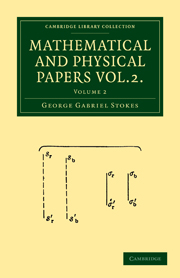Book contents
- Frontmatter
- Contents
- Notes on Hydrodynamics. III. On the Dynamical Equations
- On the constitution of the Luminiferous Ether
- On the Theory of certain Bands seen in the Spectrum
- Notes on Hydrodynamics. IV. Demonstration of a Fundamental Theorem
- On a difficulty in the Theory of Sound
- On the Formation of the Central Spot of Newton's Rings beyond the Critical Angle
- On some points in the Received Theory of Sound
- On the perfect Blackness of the Central Spot in Newton's Rings, and on the Verification of Fresnel's Formula for the intensities of Reflected and Reflacted Rays
- On Attractions, and on Clairaut's Theorem
- On the Variation of Gravity at the Surface of the Earth
- On a Mode of Measuring the Astigmatism of a Defective Eye
- On the Determination of the Wave Length corresponding with any Point of the Spectrum
- Discussion of a Differential Equation relating to the Breaking of Railway Bridges
- Notes on Hydrodynamics, VI. On Waves
- On the Dynamical Theory of Diffraction
- On the Numerical Calculation of a class of Definite Integrals and Infinite Series
- On the Mode of Disappearance of Newton's Rings in passing the Angle of Total Internal Reflection
- On Metallic Reflection
- On a Fictitious Displacement of Fringes of Interference
- On Haidinger's Brushes
- Index
On Attractions, and on Clairaut's Theorem
Published online by Cambridge University Press: 07 September 2010
- Frontmatter
- Contents
- Notes on Hydrodynamics. III. On the Dynamical Equations
- On the constitution of the Luminiferous Ether
- On the Theory of certain Bands seen in the Spectrum
- Notes on Hydrodynamics. IV. Demonstration of a Fundamental Theorem
- On a difficulty in the Theory of Sound
- On the Formation of the Central Spot of Newton's Rings beyond the Critical Angle
- On some points in the Received Theory of Sound
- On the perfect Blackness of the Central Spot in Newton's Rings, and on the Verification of Fresnel's Formula for the intensities of Reflected and Reflacted Rays
- On Attractions, and on Clairaut's Theorem
- On the Variation of Gravity at the Surface of the Earth
- On a Mode of Measuring the Astigmatism of a Defective Eye
- On the Determination of the Wave Length corresponding with any Point of the Spectrum
- Discussion of a Differential Equation relating to the Breaking of Railway Bridges
- Notes on Hydrodynamics, VI. On Waves
- On the Dynamical Theory of Diffraction
- On the Numerical Calculation of a class of Definite Integrals and Infinite Series
- On the Mode of Disappearance of Newton's Rings in passing the Angle of Total Internal Reflection
- On Metallic Reflection
- On a Fictitious Displacement of Fringes of Interference
- On Haidinger's Brushes
- Index
Summary
Clairaut's Theorem is usually deduced as a consequence of the hypothesis of the original fluidity of the earth, and the near agreement between the numerical values of the earth's ellipticity, deduced independently from measures of arcs of the meridian and from pendulum experiments, is generally considered as a strong confirmation of the hypothesis. Although this theorem is usually studied in connection with the hypothesis just mentioned, it ought to be observed that Laplace, without making any assumption respecting the constitution of the earth, except that it consists of nearly spherical strata of equal density, and that its surface may be regarded as covered by a fluid, has established a connexion between the form of the surface and the variation of gravity, which in the particular case of an oblate spheroid gives directly Clairaut's Theorem. If, however, we merely assume, as a matter of observation, that the earth's surface is a surface of equilibrium, (the trifling irregularities of the surface being neglected), that is to say that it is perpendicular to the direction of gravity, then, independently of any particular hypothesis respecting the state of the interior, or any theory but that of universal gravitation, there exists a necessary connexion between the form of the surface and the variation of gravity along it, so that the one being given the other follows.
- Type
- Chapter
- Information
- Mathematical and Physical Papers , pp. 104 - 130Publisher: Cambridge University PressPrint publication year: 2009First published in: 1883



